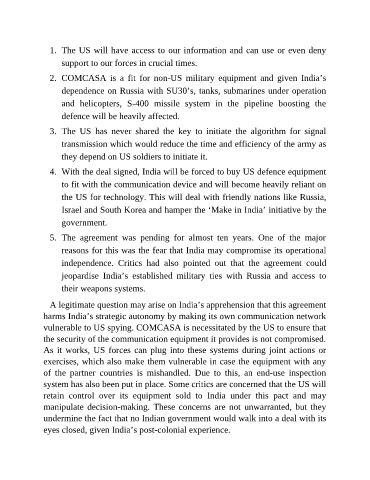Page 642 - SSB Interview: The Complete Guide, Second Edition
P. 642
1. The US will have access to our information and can use or even deny
support to our forces in crucial times.
2. COMCASA is a fit for non-US military equipment and given India’s
dependence on Russia with SU30’s, tanks, submarines under operation
and helicopters, S-400 missile system in the pipeline boosting the
defence will be heavily affected.
3. The US has never shared the key to initiate the algorithm for signal
transmission which would reduce the time and efficiency of the army as
they depend on US soldiers to initiate it.
4. With the deal signed, India will be forced to buy US defence equipment
to fit with the communication device and will become heavily reliant on
the US for technology. This will deal with friendly nations like Russia,
Israel and South Korea and hamper the ‘Make in India’ initiative by the
government.
5. The agreement was pending for almost ten years. One of the major
reasons for this was the fear that India may compromise its operational
independence. Critics had also pointed out that the agreement could
jeopardise India’s established military ties with Russia and access to
their weapons systems.
A legitimate question may arise on India’s apprehension that this agreement
harms India’s strategic autonomy by making its own communication network
vulnerable to US spying. COMCASA is necessitated by the US to ensure that
the security of the communication equipment it provides is not compromised.
As it works, US forces can plug into these systems during joint actions or
exercises, which also make them vulnerable in case the equipment with any
of the partner countries is mishandled. Due to this, an end-use inspection
system has also been put in place. Some critics are concerned that the US will
retain control over its equipment sold to India under this pact and may
manipulate decision-making. These concerns are not unwarranted, but they
undermine the fact that no Indian government would walk into a deal with its
eyes closed, given India’s post-colonial experience.

